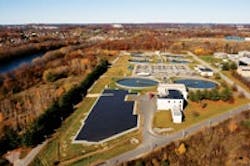Green Commitment
Meredith S. Zona, P.E., LEED AP, is vice president of Fay, Spofford & Thorndik. Zona can be reached at [email protected]. James M. Bing, P.E., is president of NEO Virtus Eng. Inc. Bing can be reached at [email protected].
undefinedA group of communities in Massachusetts and New Hampshire recently became important parts of the “new energy” revolution. At the Greater Lawrence Sanitary District (GLSD), two different renewable energy solutions were implemented. These upgrades not only promote green concepts in the environmental sense, but also green concepts in the more traditional sense, as they ultimately will reduce costs for the district.
GLSD—serving Lawrence, Andover, Methuen, North Andover and Dracut, Mass., and Salem, N.H.—recently completed several energy upgrades. Two of these upgrades involved renewable energy: the installation of two dual-fuel steam boilers at its wastewater treatment plant, and the addition of a ground-mounted solar photovoltaic (PV) system.
In their mission to implement energy and environmental reform, municipalities across the country often are faced with the same question: What kind of alternative energy strategies will not only save a significant amount of money, but also have minimal environmental impact and serve as a source of goodwill for local residents?
With these two renewable energy upgrades, GLSD appears to have found the answer.
A New Use for Excess Gas
GLSD’s treatment facility is capable of processing up to 52 million gal per day (mgd) of wastewater, with the average daily flow typically at 31 mgd. The treatment system includes primary sedimentation, biological oxidation, secondary clarification and treated effluent chlorination.
The district’s wastewater treatment plant is one of six in Massachusetts that either utilizes anaerobic digestion or is in the process of installing anaerobic digesters. Built in 2002, GLSD’s system features three anaerobic digesters for a total capacity of 4.2 million gal. The anaerobic digestion process allows naturally occurring microorganisms to break down waste solids, which produces methane, carbon dioxide and several other trace gases. This is more commonly known as biogas. At GLSD, the biogas is used to maintain digester temperatures, and for onsite sludge drying and pelletizing.
Originally, the excess gas was captured and flared. Today, it is being used productively for building heating and domestic hot water. The plant added two new boilers with dual-fuel burners capable of burning both biogas and natural gas. These boilers use less water and produce steam more efficiently, largely replacing older ones that operate on natural gas and fuel oil. Burning biogas for building heating and hot water makes use of an energy resource produced on site, while also reducing a dependence on fossil fuels. Furthermore, the upgrades lead to a decrease in the flaring of biogas, which reduces greenhouse gas emissions.
Other significant upgrades in conjunction with the boiler installation were designed to reduce energy consumption and the facility’s carbon footprint, as well as improve process efficiency and comfort levels in the plant’s office areas. These upgrades included HVAC improvements and the installation of variable-frequency drives and more efficient motors, pumps and controls.
A Strong Green Initiative
GLSD’s green commitment did not end there. It added a ground-mounted PV system, which consists of 210-W Kyocera-model solar panels for a total capacity of 441 kW. The PV system is split between two sites. Site No. 1 is comprised of 1,800 solar panels connected in 120 “strings,” or source circuits of 15 solar panels in series. The strings are grouped into sets of 10 strings in PV combiner boxes. Three combiner boxes form the input to an inverter. For Site No. 1, this pattern is repeated four times for a total of four 82-kW inverters.
Site No. 2 is comprised of 300 panels connected in 20 strings of 15 solar panels in series. The series strings also are combined in sets of 10 strings in PV combiner boxes. For this site, two combiner boxes form the input to a single 60-kW inverter.
Untapped Renewable Energy
GLSD’s two renewable energy upgrades will benefit the communities it serves both financially and environmentally. According to an energy evaluation audit, with the installation of the new boilers, natural gas savings are expected to be about $81,000 annually (based on $12.42/MMBtu), and carbon dioxide and methane emissions will be
significantly reduced.
Meanwhile, the PV system will save GLSD approximately $59,000 per year in electricity costs (based on $0.106 per kilowatt-hour). The solar arrays will generate enough electricity to power the equivalent of about 80 Massachusetts homes. Also, solar renewable-energy certificates will be available for GLSD to generate revenue through the renewable energy credit market.
The GLSD project is proving that wastewater treatment plants can be an untapped source of renewable energy. It also serves as an example of how being diverse with renewable energy projects can yield tremendous economic and environmental value. In a time of high energy costs and endless discussions regarding global warming, renewable energy success certainly is most welcome.
Download: Here
